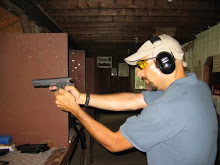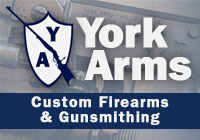There is simply no way to cover - even as a skim - all the various permutations out there. Shooting Times has an excellent ballistic table for many rifle and handgun calibers which covers the velocity and the energy of the round both at the muzzle and out to 50 yards. Different bullet weights and types are covered in this table, which can be used as a rough comparison of one caliber to another.
For starters, let's run through some of the acronyms the new shooter is likely to come across:
ACP: Automatic Colt Pistol. Refers to a round designed by John Moses Browning (PBUH) for use in autoloading firearms. All ACP-designated rounds have the same proportional dimensions.
FMJ: Full Metal Jacket. Refers to a solid-tipped bullet, usually copper.
LR: Long Rifle. Designation for the most common rimfire round of them all.
JHP: Jacketed Hollow Point. Refers to a bullet with a hollow center designed to "mushroom" upon hitting something solid.
S&W: Smith & Wesson
Next, let's consider the most "mainstream" of the handgun rounds. These are the rounds most likely to be found in any Wal-Mart, general store, or small gun shop, arranged by size:
.22 LR
.25 ACP
.32ACP
.380 ACP
.38 Special
.357 Magnum
9mm
.40 S&W
.44 Magnum
.45 ACP
The above calibers should be present in pretty much any store that sells ammunition anywhere in the US. There are dozens upon dozens of handgun rounds out there, but these are the "Top Ten" if you will, the best sellers currently available. Temporary shortages aside (.380ACP, I'm looking at yoooouuuuu), all of these calibers should be relatively easy to purchase. For a new shooter (someone new to the shooting world), I would not recommend a caliber not on this list as a "first" or "only" gun. Even the .357 Sig - which is a police-issued round - is hard to find and supremely expensive, not quite as exotic as 10mm but still on the harder side to find.
Which of the above calibers to choose is a matter of intensely heated and mostly pointless debate. For self-defense, the main idea is to have a round that will incapacitate an attacker quickly, meaning that the energy expended upon impact should be great. The downside to this, of course, is perceived recoil - how "hard" the gun feels in the hand when fired. A S&W 500 Magnum has pretty impressive stopping power for anything short of a pachyderm, but hurts to fire (both physically and financially). Too small of a round runs the risk of not incapacitating an attacker fast enough; too "hot" of a round (high muzzle velocity) may potentially penetrate too well and not do enough damage due to the speed at which the round passes through the body.
With modern ammunition, using a good hollowpoint design, anything larger than .32 ACP should be sufficient for self defense. .380 ACP and .38 Special should be +P designations (more powder for more power) for optimal self defense. While the age-old "9mm vs. .45 ACP" caliber war may rage ever onward in the annals of gunnie lore, the truth is that with modern +P hollowpoint ammunition, there's little practical difference between the two calibers.
Price. This is intended as a general guideline based on what I've seen recently in my area. With the exception of .22LR, all prices are for 50 rounds. Where applicable, pricing is broken into FMJ ammo (like used for practice) and JHP (for defense) applications. We'll consider the above cartridges:
.22 LR - box of 500 - 550 rounds ("bulk pack") typically runs ~ $20
.25 ACP - $15 for FMJ, $25+ for JHP
.32ACP - about the same as .25 ACP
.380 ACP - $20 for FMJ, $30+ for JHP when you can find it
.38 Special - $15 for FMJ, $25+ for JHP; reloaded semi-lead wadcutters (SLWC) can be found for ~ $12
.357 Magnum - $18 for FMJ, $30+ for JHP; reloaded SLWC can be found for ~ $15
9mm - $12 for FMJ, $20+ for JHP
.40 S&W - $15 for FMJ, $25+ for JHP
.44 Magnum - $35 for FMJ, $45+ for JHP
.45 ACP - $22 for FMJ, $30+ for JHP
Obviously these prices are not absolute, but a rough idea of what exactly to expect when going to purchase ammunition for one's firearm. Price and availability of ammo should be a consideration in choosing a defensive arm - the greatest handgun in the world is a very poor club if you can't put any ammunition in it. Missing with $40/box ammo is much worse than hitting with $15/box ammo...
Miscellany.
- .38 Special isn't .38" in diameter. It's really .357". .38 Special will fit and fire perfectly safely in a revolver chambered for .357 Magnum, but not the reverse. The rounds are specifically engineered so that the more powerful .357 Magnum cannot fit in a .38 Special-chambered revolver.
- .380 ACP is sometimes referred to as 9mm Kurtz or 9mm short. It cannot be fired in a 9mm-chambered pistol - this is quite dangerous AAMOF.
- What is traditionally called 9mm ammo is actually 9X19mm (19mm referring to the case length). It is sometimes called 9mm Parabellum, 9mm Luger, or 9mm NATO. It is NOT 9mm Largo or Steyr.
- As a general rule of thumb, handgun rounds are either revolver-specific (often a "rimmed" cartridge meaning that the base sticks out more than the case) or automatic-specific (straight-walled for easier loading). There are revolvers that fire 9mm or .45 ACP (using what are called moon clips, usually); there are semi-automatic pistols chambered in .38 Special, .357 Magnum, and .44 Magnum (among others). Only the .22LR is fully represented in both styles of action.
This is obviously a most basic start to handgun calibers. We've stayed away from esoteric cartridges like the .357 SIG or the .45 GAP; we've refrained from getting into a discussion of some of the "legacy" cartridges like .45 Long Colt or .38 Super; basically, this is a bare-bones list for someone brand new to shooting in general so that they can get a quick feel for what's out there. The exclusion of your particular favorite blaster fodder does not mean it's no good; it could simply be uncommon, expensive, or both and therefore less-than-perfect for a noob.
What other calibers/items of note should be included in this discussion for the next set?
That is all.







19 comments:
"While the age-old "9mm vs. .45 ACP" caliber war may rage ever onward in the annals of gunnie lore, the truth is that with modern +P hollowpoint ammunition, there's little practical difference between the two calibers."
Oh dear. Now you done it. That's a BIG can o' worms you done opened.
So, you just let the tyro make their own conclusion? You're not gonna make a specific recommendation? You're not going to tell your reader which you personally carry/prefer?
Heck no. That'd be biasing the jury pool, as it were. Besides, everyone knows that there is only one true handgun caliber - .30 Luger...
I beg to differ, the one true caliber is 7.62 Tokarev!
Don't forget - the true *optimal* caliber for your carry gun is . . . the caliber that you will actually tote about and practice with on a regular basis. That's way more important than the number on the shell casing.
Even the .357 Sig - which is a police-issued round - is hard to find and supremely expensive.
Not if you know a cop who can get you free ammo.... (:
Also, if you're willing to shell out the dough for a case (or more) then .357 SIG isn't all that expensive. No more than .45ACP anyway.
Great post, Jay. One nit to pick. I belive the designation you are looking for is "Lead Semi-Wadcutter" rather than implying that the bullet isn't all-the-way lead.
And for clarification for unnamed interested parties. "Wadcutter" is a bullet shaped like a soup can. They're cheap to make and shoot, and they are super-fun for target practice because they cut a very clean round hole in the target.
Semi-wad cutter is above soup-can shape but with a pyramid with a flat-top on the business end.
http://en.wikipedia.org/wiki/Semiwadcutter
Dur. Thanks for the clarification, Weerd. I plead a senior moment, combined with "car lag"... ;)
Even the .357 Sig - which is a police-issued round - is hard to find and supremely expensive, not quite as exotic as 10mm but still on the harder side to find.
My local Wally World has half a case of .357 Sig, and has had it for 8 months.
Meanwhile, they haven't had .380 ACP since January... of 2009.
"While the age-old "9mm vs. .45 ACP" caliber war may rage ever onward in the annals of gunnie lore, the truth is that with modern +P hollowpoint ammunition, there's little practical difference between the two calibers."
The loud whirring you are currently hearing is Col. Cooper spinning in his grave.....(grin)
Don't forget that 9x18 is an entirely separate caliber from .380/9x17 and 9x19.
I think new shooters should confine themselves to ammo they buy at stores. Otherwise they're liable to wind up with 9mm rounds meant for an SMG or corrosive ammo or who knows what else. Buying at the store is more expensive but keeps you in safe territory when it comes to feeding a normal gun.
Further to Wolfwood's comment, your third Miscellany bullet point should include that "9mm" is also not 9mm Makarov.
This isn't the issue it was several years ago, but I saw 9mm Makarov pistols at a show just last weekend.
They were inexpensive enough to be tempting.
Another nitpick. You say:
JHP: Jacketed Hollow Point. Refers to a bullet with a hollow center designed to "mushroom" upon hitting something solid.
... when really HP bullets are designed to expand/mushroom when they impact tissue, or a likewise fluid filled/based material. My point is to emphasize that bullets don't expand when they hit walls or cars; they expand when they hit flesh, water filled jugs, etc.
Granted, bullets may deform when they hit something solid - but thats not the point you are making with regard to JHPs.
Carry on.
My local Wally World has half a case of .357 Sig, and has had it for 8 months.
Yup, I've been able to find .357 SIG at reasonable prices for the entirety of the "ammo scare" .40 S&W has been even cheaper and easier to get.
The .357 is usually about $2/box more than what you'd pay for UMC or WWB .45 at walmart.
Great info, Jay! Especially for n00bish people. :)
I can get .380, it's .45 ACP that's currently hard to find.
Wrote this a couple years ago:
http://anarchangel.blogspot.com/2006/01/serious-chamberings-for-serious.html
One question...Why would a handgun manual say "Do not fire 9mm Parabellum ammunition designed for a submachine gun."? Isn't 9mm Parabellum 9mm parabellum no matter what? I would think that maybe it is loaded heavier, but the gun is rated for +P.
Anon,
I think it's because ammo for subguns is or used to be loaded hotter to reliably cycle in the faster rate of fire.
It's only an issue with 9mm and 7.62 Tok, IIRC...
Post a Comment